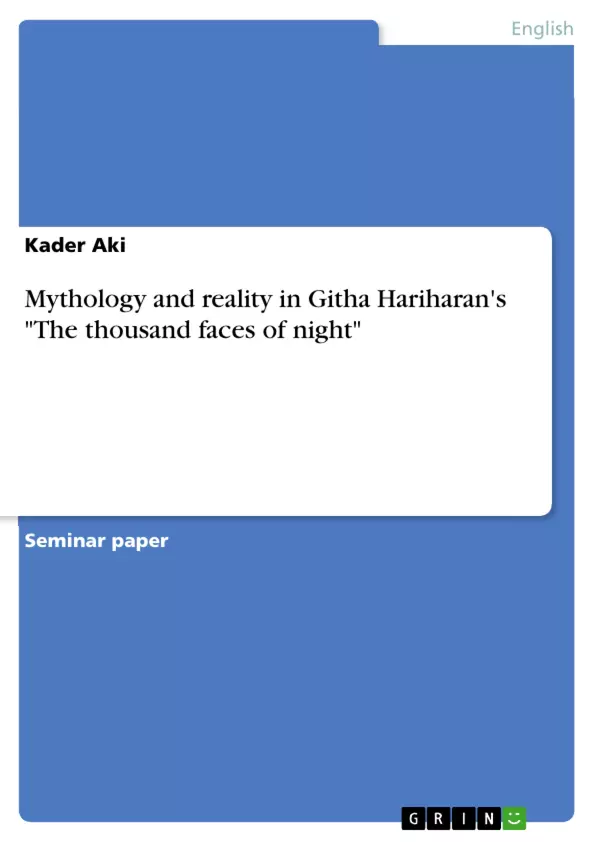"The Thousand Faces of Night" is not just a womanist novel but it is a definite feminist writing in which myths are revisioned, rewritten, and retold from a female point of view. The focus of the novel is on the inner lifes of women, the 'inner spaces' are reflected in detail.
The analysis on hand sets its central focus on the relation between myth or stories and the women in the Novel. It presents how the female point of view differs from the male discourse, especially by contrasting myths form the Mahabharata with stories from the Sanskrit. A brief explanation about Manu is included, as well as a rudimentary interpretation of Gita Hariharan's use of metaphors are included.
Table of Contents
- Introduction
- Indian Womanist Writing
- Revisioning Myth and Reality in Three Generations
- Mother-Daughter Relationship
- Grandmother's Retellings from the Mahabharata
- Between Myth and Reality
- The Swayamvara
- Blind Anger
- The Snake Man
- A Female Revenger
- Mayamma's Memories
- The Male Discourse
- Mahesh's Expectations as a Husband
- Motherhood as a Male Concern
- Manu and Women
- Guiding Stories of Baba
Objectives and Key Themes
This paper examines the relationship between myth and women in Githa Hariharan's novel, *The Thousand Faces of Night*, analyzing how the female perspective contrasts with the male discourse. It explores the re-visioning of myths from the Mahabharata and Sanskrit literature, focusing on the impact of these narratives on the lives of women across generations. The paper also briefly discusses metaphors employed by Hariharan.
- The revisioning of myths from a female perspective
- The contrast between female and male discourses
- The impact of traditional narratives on the lives of women
- The representation of women across generations
- The use of metaphors to convey themes of female identity and agency
Chapter Summaries
The introduction sets the stage by describing *The Thousand Faces of Night* as a feminist novel that revisits and reinterprets myths from a female perspective. The focus is on the internal lives and experiences of women, particularly their relationships with traditional narratives and societal expectations.
Chapter 2, "Indian Womanist Writing," examines the context of Indian feminist writing in the 1980s, where women began to challenge the patriarchal interpretations of myths and reclaim their agency. The chapter emphasizes the importance of revising traditional narratives to address gender injustice and the changing roles of women in Indian society.
Chapter 3, "Revisioning Myth and Reality in Three Generations," delves into the lives of three women: Devi, Sita, and Mayamma. It explores how their experiences, shaped by both real-life stories and mythological narratives, reflect the ongoing struggle against gender inequality. Devi, as the narrator, retells these stories, providing different perspectives on the shared experiences of women across generations.
Chapter 3.1, "Mother-Daughter Relationship," specifically focuses on the complex dynamic between Devi and her mother, Sita. It highlights the ways in which Sita embodies traditional expectations of womanhood, while Devi seeks to break free from these constraints. The chapter discusses Devi's search for identity and her eventual return to her mother, signifying a shift in their relationship.
Chapter 3.2, "Grandmother's Retellings from the Mahabharata," analyzes the role of Devi's grandmother in transmitting traditional narratives and their influence on Devi's understanding of the world. The chapter explores specific tales from the Mahabharata, including "The Swayamvara," "Blind Anger," "The Snake Man," and "A Female Revenger," to demonstrate how these myths can be reinterpreted through a female lens.
Keywords
The main keywords and focus topics of the text include Indian feminist writing, myth revisioning, gender injustice, female perspective, Mahabharata, Sanskrit literature, mother-daughter relationship, and female identity. These terms reflect the core themes and concepts explored in the analysis of *The Thousand Faces of Night*, showcasing the author's exploration of how traditional narratives intersect with the lived experiences of women in India.
- Quote paper
- Kader Aki (Author), 2002, Mythology and reality in Githa Hariharan's "The thousand faces of night", Munich, GRIN Verlag, https://www.grin.com/document/57396



